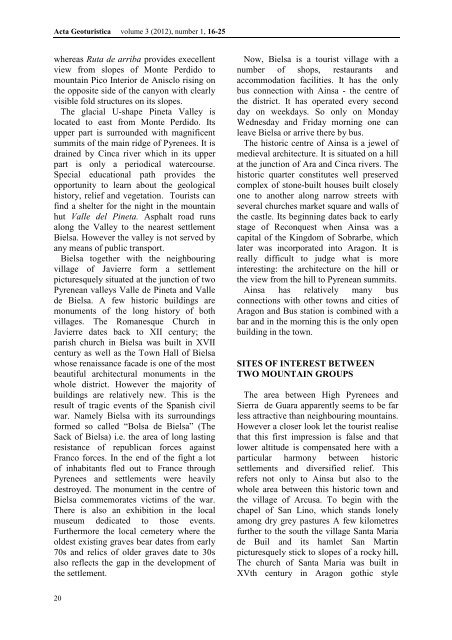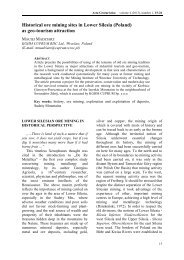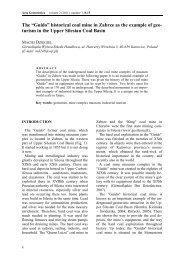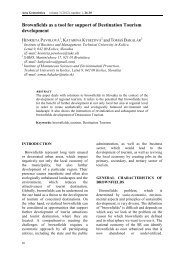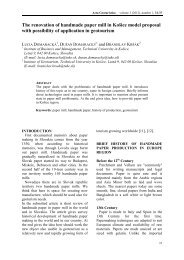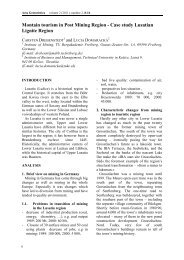Interweaving Geological and Cultural Heritages ... - Acta Geoturistica
Interweaving Geological and Cultural Heritages ... - Acta Geoturistica
Interweaving Geological and Cultural Heritages ... - Acta Geoturistica
Create successful ePaper yourself
Turn your PDF publications into a flip-book with our unique Google optimized e-Paper software.
<strong>Acta</strong> <strong>Geoturistica</strong> volume 3 (2012), number 1, 16-25<br />
whereas Ruta de arriba provides execellent<br />
view from slopes of Monte Perdido to<br />
mountain Pico Interior de Anisclo rising on<br />
the opposite side of the canyon with clearly<br />
visible fold structures on its slopes.<br />
The glacial U-shape Pineta Valley is<br />
located to east from Monte Perdido. Its<br />
upper part is surrounded with magnificent<br />
summits of the main ridge of Pyrenees. It is<br />
drained by Cinca river which in its upper<br />
part is only a periodical watercourse.<br />
Special educational path provides the<br />
opportunity to learn about the geological<br />
history, relief <strong>and</strong> vegetation. Tourists can<br />
find a shelter for the night in the mountain<br />
hut Valle del Pineta. Asphalt road runs<br />
along the Valley to the nearest settlement<br />
Bielsa. However the valley is not served by<br />
any means of public transport.<br />
Bielsa together with the neighbouring<br />
village of Javierre form a settlement<br />
picturesquely situated at the junction of two<br />
Pyrenean valleys Valle de Pineta <strong>and</strong> Valle<br />
de Bielsa. A few historic buildings are<br />
monuments of the long history of both<br />
villages. The Romanesque Church in<br />
Javierre dates back to XII century; the<br />
parish church in Bielsa was built in XVII<br />
century as well as the Town Hall of Bielsa<br />
whose renaissance facade is one of the most<br />
beautiful architectural monuments in the<br />
whole district. However the majority of<br />
buildings are relatively new. This is the<br />
result of tragic events of the Spanish civil<br />
war. Namely Bielsa with its surroundings<br />
formed so called “Bolsa de Bielsa” (The<br />
Sack of Bielsa) i.e. the area of long lasting<br />
resistance of republican forces against<br />
Franco forces. In the end of the fight a lot<br />
of inhabitants fled out to France through<br />
Pyrenees <strong>and</strong> settlements were heavily<br />
destroyed. The monument in the centre of<br />
Bielsa commemorates victims of the war.<br />
There is also an exhibition in the local<br />
museum dedicated to those events.<br />
Furthermore the local cemetery where the<br />
oldest existing graves bear dates from early<br />
70s <strong>and</strong> relics of older graves date to 30s<br />
also reflects the gap in the development of<br />
the settlement.<br />
Now, Bielsa is a tourist village with a<br />
number of shops, restaurants <strong>and</strong><br />
accommodation facilities. It has the only<br />
bus connection with Ainsa - the centre of<br />
the district. It has operated every second<br />
day on weekdays. So only on Monday<br />
Wednesday <strong>and</strong> Friday morning one can<br />
leave Bielsa or arrive there by bus.<br />
The historic centre of Ainsa is a jewel of<br />
medieval architecture. It is situated on a hill<br />
at the junction of Ara <strong>and</strong> Cinca rivers. The<br />
historic quarter constitutes well preserved<br />
complex of stone-built houses built closely<br />
one to another along narrow streets with<br />
several churches market square <strong>and</strong> walls of<br />
the castle. Its beginning dates back to early<br />
stage of Reconquest when Ainsa was a<br />
capital of the Kingdom of Sobrarbe, which<br />
later was incorporated into Aragon. It is<br />
really difficult to judge what is more<br />
interesting: the architecture on the hill or<br />
the view from the hill to Pyrenean summits.<br />
Ainsa has relatively many bus<br />
connections with other towns <strong>and</strong> cities of<br />
Aragon <strong>and</strong> Bus station is combined with a<br />
bar <strong>and</strong> in the morning this is the only open<br />
building in the town.<br />
SITES OF INTEREST BETWEEN<br />
TWO MOUNTAIN GROUPS<br />
The area between High Pyrenees <strong>and</strong><br />
Sierra de Guara apparently seems to be far<br />
less attractive than neighbouring mountains.<br />
However a closer look let the tourist realise<br />
that this first impression is false <strong>and</strong> that<br />
lower altitude is compensated here with a<br />
particular harmony between historic<br />
settlements <strong>and</strong> diversified relief. This<br />
refers not only to Ainsa but also to the<br />
whole area between this historic town <strong>and</strong><br />
the village of Arcusa. To begin with the<br />
chapel of San Lino, which st<strong>and</strong>s lonely<br />
among dry grey pastures A few kilometres<br />
further to the south the village Santa Maria<br />
de Buil <strong>and</strong> its hamlet San Martin<br />
picturesquely stick to slopes of a rocky hill.<br />
The church of Santa Maria was built in<br />
XVth century in Aragon gothic style<br />
20


